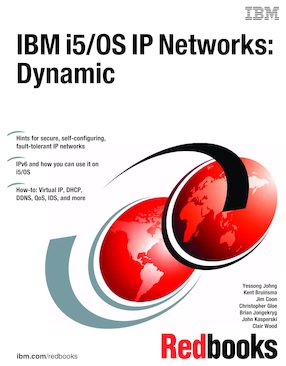Abstract
Over the course of many years, the developers in both the Endicott and Rochester labs have been working very hard adding
functions to each release of OS/400 and i5/OS to make the configuration and use of the IBM System i in a TCP/IP network easier and more powerful. If you need to design an IP network that is self-configuring, fault-tolerant, secure, and efficient in its operation, then this IBM Redbooks publication is for you.
We start low with the details of IP interface and route implementation on i5/OS. Through the study of these building blocks, we show how to create IP networks that are easier to configure, tolerant of faults, and can perform both inbound and
outbound load balancing.
i5/OS has always had many built-in Network Security features. These features have been enhanced to include an Intrusion Detection System (IDS). This allows you to be notified of attempts to hack into, disrupt, or deny service to the system.
Moving up to the application layer, we demonstrate the dynamic power of IP by having the DHCP server assigning IP addresses and automatically updating the i5/OS Dynamic DNS. Now clients and servers can be added dynamically to the IP network and assigned a name automatically.
Table of Contents
Part 1. Zen and the art of dynamic IP
Chapter 1. An introduction to the protocols at hand
Chapter 2. Interfaces, routes, and Virtual IP
Chapter 3. IPv6: the next generation of the Internet
Chapter 4. Multilink Protocol
Chapter 5. Point-to-Point Protocol (PPP)
Chapter 6. Dynamic Host Configuration Protocol (DHCP)
Chapter 7. Routing Information Protocol Version 2 (RIPv2)
Chapter 8. Dynamic Domain Name System (Dynamic DNS)
Chapter 9. Remote Authentication Dial-In User Service (RADIUS)
Chapter 10. Quality of Service (QoS)
Chapter 11. Intrusion Detection System (IDS)
Part 2. Scenarios
Chapter 12. Defining adaptable TCP/IP interfaces and routes
Chapter 13. Virtual Ethernet within an LPAR environment
Chapter 14. Multilink in action
Chapter 15. DHCP: Dynamic allocation of IP addresses
Chapter 16. Dynamic DNS scenarios
Chapter 17. Dynamic PPP scenarios
Chapter 18. QoS scenarios
Part 3. Advanced administration
Chapter 19. Optimizing performance in a TCP/IP network
Chapter 20. Considerations for starting and ending TCP/IP
Chapter 21. Checking TCP/IP status programmatically
Chapter 22. Using alias names and setting proxy ARP and preferred interface lists programmatically
Chapter 23. Using exit programs
Chapter 24. Problem determination: where to start when things do not work
Appendix A. Additional material
Appendix B. IPv6 reference information
Others who read this also read
